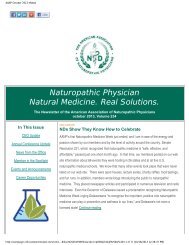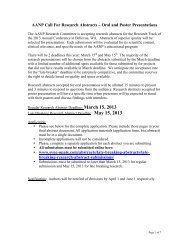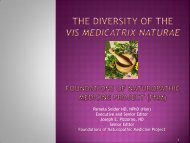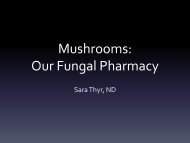Herbal Tea Practicum: The World of Healing in a Simple Cup of Tea.
Herbal Tea Practicum: The World of Healing in a Simple Cup of Tea.
Herbal Tea Practicum: The World of Healing in a Simple Cup of Tea.
Create successful ePaper yourself
Turn your PDF publications into a flip-book with our unique Google optimized e-Paper software.
ags, but we must still be able to make simple and effective teas. If youdon’t recommend teas to your patients you are tell<strong>in</strong>g them that they areunreliable and not worth the effort. <strong>The</strong>re is a time and place for all forms <strong>of</strong>herbs, and teas are the oldest, most economical form and worthy <strong>of</strong> the effortto learn.What is a tea?To beg<strong>in</strong>, the word herbal tea is actually wrong. All teas technically reflectthe use <strong>of</strong> tea or Camillia s<strong>in</strong>ensis <strong>in</strong>fusion. <strong>Herbal</strong> tea is actually an herbal<strong>in</strong>fusion, or decoction <strong>of</strong> any plant that is not tea. <strong>The</strong>se are the two primaryways that herbs are made <strong>in</strong>to water-soluble extracts. <strong>The</strong> French call themherbal tisanes and they are the primary way we extract water-solubleconstituents from plants. We can use hot water, warm water or even coldwater depend<strong>in</strong>g on what we are try<strong>in</strong>g to extract. We can make <strong>in</strong>fusions ordecoctions.Hot Water Infusion: Hot water steep<strong>in</strong>gAn herbal <strong>in</strong>fusion is a water-based extract usually us<strong>in</strong>g boil<strong>in</strong>g water as themenstruum. <strong>The</strong>re are two methods to measure out the tea. <strong>The</strong> folk methodwhich is usually a teaspoon <strong>of</strong> herb to 1 cup ( 8 oz) <strong>of</strong> water, and thescientific measurement method which <strong>in</strong>cludes weigh<strong>in</strong>g the herb andmeasur<strong>in</strong>g the water. <strong>The</strong> general method is to br<strong>in</strong>g a high quality filteredor spr<strong>in</strong>g water to a boil, and pour it over the herb; then cover and let it steepfor 3-10 m<strong>in</strong>utes. <strong>The</strong>n stra<strong>in</strong> out the herb and dr<strong>in</strong>k the <strong>in</strong>fusion. This is aclassic hot water <strong>in</strong>fusion. <strong>The</strong> key is boil<strong>in</strong>g water, cover the herb, andsteep. This method <strong>in</strong>volves no boil<strong>in</strong>g <strong>of</strong> the herb and is best for flowers,leaves and aromatic herbs. It would be reasonable that any herb that has a lot<strong>of</strong> aroma would be best prepared by hot water <strong>in</strong>fusion. <strong>The</strong> terpenes arearomatic and will be lost to the air if boiled. <strong>The</strong>re are a lot <strong>of</strong> variablesdepend<strong>in</strong>g on how much herb you use, how long you steep the herbs and <strong>of</strong>course the quality <strong>of</strong> the herb. <strong>The</strong> dos<strong>in</strong>g <strong>of</strong> an herb is very <strong>in</strong>dividualdepend<strong>in</strong>g on the strength and herb but a general dose is 2-4 cups a day.Most herbal <strong>in</strong>fusions that you buy <strong>in</strong> tea bags are designed to taste good and<strong>Herbal</strong> <strong>Tea</strong> <strong>Practicum</strong>: <strong>The</strong> world <strong>of</strong> heal<strong>in</strong>g <strong>in</strong> a simple cup <strong>of</strong> tea. AANP 2013 Page 3
are <strong>in</strong> general low potency, or as I call 'good taste strength'. In general thereare about 2-3 grams <strong>of</strong> herb to each tea bag. A medic<strong>in</strong>al tea strength isabout 2x or more stronger or 4-6 grams per cup. Th<strong>in</strong>k <strong>of</strong> the idea <strong>of</strong> onetea bag for a tasty beverage and 2 for a medic<strong>in</strong>al beverage. You can <strong>of</strong>course make a weaker <strong>in</strong>fusion and have a patient dr<strong>in</strong>k more, but rememberthat taste is the new active <strong>in</strong>gredient, so don’t make it super strong ornobody will be able to handle it.<strong>The</strong> Long Infusion: <strong>The</strong> long <strong>in</strong>fusion is the same method <strong>of</strong> hot water<strong>in</strong>fusion. <strong>The</strong> only difference is the long time used to <strong>in</strong>fuse the herbs. Thisis a common method that I use to fully extract the water soluble constituents<strong>in</strong> the plant material. Most <strong>of</strong> the aromatic terpenes extract quickly <strong>in</strong> hotwater, usually <strong>in</strong> a few m<strong>in</strong>utes, but the m<strong>in</strong>erals and other glycosides maytake longer. This is why the long <strong>in</strong>fusion is useful and it is best to extractm<strong>in</strong>erals and nutrients that are water soluble. I like to start these at nightbefore bed and then stra<strong>in</strong> them <strong>in</strong> the morn<strong>in</strong>g so that there is an 8 hour<strong>in</strong>fusion time. After stra<strong>in</strong><strong>in</strong>g, the herb <strong>in</strong>fusion can be warmed or drunkcold depend<strong>in</strong>g on the need. In w<strong>in</strong>ter generally we want the teas to bewarm<strong>in</strong>g; <strong>in</strong> the summer or for hot conditions, dr<strong>in</strong>k them cool to cold. I liketo use a dedicated, French press. Add the herbs to the French press, then addthe boil<strong>in</strong>g water and cover. In the morn<strong>in</strong>g, press down the top and reheatthe <strong>in</strong>fusion. This can be done <strong>in</strong> a pan with a top also.Cold Water Infusion: <strong>The</strong> cold water <strong>in</strong>fusion <strong>in</strong>volves no heat<strong>in</strong>g <strong>of</strong> thewater. Just place the herbs <strong>in</strong> cool water and <strong>in</strong>fuse to the desired strength.This is similar to sun teas where the herbs are placed cold <strong>in</strong> a glassconta<strong>in</strong>er then placed <strong>in</strong> the sun. This method is best for extract<strong>in</strong>g the slimyparts or herbs, such as mucilage. <strong>The</strong> steep<strong>in</strong>g time can be <strong>in</strong>creased to hoursbecause the extract<strong>in</strong>g strength <strong>of</strong> cold water is much lower than hot water.This is best for herbs like Slippery Elm, Althea which is Marshmallow rootand Comfrey (Symphytum).<strong>Herbal</strong> <strong>Tea</strong> <strong>Practicum</strong>: <strong>The</strong> world <strong>of</strong> heal<strong>in</strong>g <strong>in</strong> a simple cup <strong>of</strong> tea. AANP 2013 Page 4
<strong>The</strong> Decoction: <strong>The</strong> br<strong>in</strong>g to a boil and simmer method<strong>The</strong> decoction is the process <strong>of</strong> boil<strong>in</strong>g and simmer<strong>in</strong>g an herb, and it isuseful for tough and woody roots, barks, seeds and fruits. It is from themiddle English decocten, to boil, from Lat<strong>in</strong> decoquere, decoct-, to boildown or away. In Ch<strong>in</strong>ese medic<strong>in</strong>e, most <strong>of</strong> the herbal prescriptions aredecoctions. <strong>The</strong> general process is to br<strong>in</strong>g the water to a boil, add the herband turn down to simmer which is a gentle boil. <strong>The</strong> herbs can be simmeredfor 20 m<strong>in</strong>utes or longer. <strong>The</strong>se decoctions can become <strong>in</strong>credibly nastytast<strong>in</strong>g; the boil<strong>in</strong>g water will extract the astr<strong>in</strong>gent tann<strong>in</strong>s and bitterpr<strong>in</strong>ciples. So it is useful to taste the decoction after a while to determ<strong>in</strong>e if itis ready. Boil<strong>in</strong>g helps break down the cellulose <strong>in</strong> plants so that they can beextracted. You can’t decoct an <strong>in</strong>fusion but you can <strong>in</strong>fuse a decoction. Thisis a fancy way to say, that if you gr<strong>in</strong>d the root or bark to a powder, you maybe able to <strong>in</strong>fuse the herb <strong>in</strong>stead <strong>of</strong> decoct it. This is a good method whenmix<strong>in</strong>g both leaves and roots. You can <strong>in</strong>fuse the whole mixture <strong>in</strong>stead <strong>of</strong>mak<strong>in</strong>g both a decoction and <strong>in</strong>fusion. <strong>The</strong> ratio <strong>of</strong> herbs to water is similarto the <strong>in</strong>fusion method. See the enclosed chart for a quick summary.Long Decoction:<strong>The</strong> long decoction is a method <strong>in</strong> which you will decoct an herb and thensimmer for a long time, generally 4-6 hours. This is a common method formedic<strong>in</strong>al mushrooms like Ganoderma and Coriolus which are woody shelffungi and are full <strong>of</strong> Chit<strong>in</strong>. Chit<strong>in</strong> is poorly water soluble but more soluble<strong>in</strong> hot water. Often Ch<strong>in</strong>ese medic<strong>in</strong>al herbs are useful as long decoctionssuch as Astragalus, Licorice and others.<strong>Tea</strong>: Taste is the new “Active Ingredient”With <strong>in</strong>creas<strong>in</strong>g exposure to natural medic<strong>in</strong>e and the ma<strong>in</strong>stream access toherbal remedies, the use <strong>of</strong> herbal medic<strong>in</strong>e is <strong>in</strong>creas<strong>in</strong>g. Natural marketsand organic groceries are stock<strong>in</strong>g more and more herbal products and<strong>in</strong>creas<strong>in</strong>gly various types <strong>of</strong> herbal teas. <strong>The</strong> general public sees herbal teasas a healthful alternative to stimulat<strong>in</strong>g caffe<strong>in</strong>e dr<strong>in</strong>ks like c<strong>of</strong>fee and Mate.<strong>The</strong> general public is dr<strong>in</strong>k<strong>in</strong>g more herbal teas but not medic<strong>in</strong>al teas--mildand flavorful blends like Apple-C<strong>in</strong>namon, or Blueberry-Coconut. <strong>The</strong>se<strong>Herbal</strong> <strong>Tea</strong> <strong>Practicum</strong>: <strong>The</strong> world <strong>of</strong> heal<strong>in</strong>g <strong>in</strong> a simple cup <strong>of</strong> tea. AANP 2013 Page 5
are a challenge to natural medic<strong>in</strong>e practitioners <strong>in</strong> that these teas taste goodbut have little useful herbs <strong>in</strong> them. <strong>The</strong> challenge for NDs is to makeuseful tonic herbal teas <strong>in</strong> forms and comb<strong>in</strong>ations that actually aretherapeutic but also taste good. If a patient refuses to dr<strong>in</strong>k one cup thenall hope is lost to get them to use this therapy long term. It is your job as theformulator to create a useful and tasty herbal tea formula. Taste is asimportant as the action <strong>of</strong> the formula. <strong>The</strong>re are some basic rules to followto <strong>in</strong>crease the compliance for mak<strong>in</strong>g teas. <strong>The</strong> first rule is do not formulatethe tea like a t<strong>in</strong>cture formula. T<strong>in</strong>ctures <strong>of</strong> herbs have their place <strong>in</strong> therapybut they are given <strong>in</strong> drop doses and are highly diluted and drunk quickly.<strong>Tea</strong> must be drunk slowly with contemplation and relaxation and for a longterm. Formulat<strong>in</strong>g tea is an art, but with some knowledge and practice, thedoctor can become a first-rate tea prescriber. Below I will list some <strong>of</strong> thetricks I have found to formulate tasty and effective teas.Enhancement <strong>of</strong> <strong>Tea</strong>Dr<strong>in</strong>k<strong>in</strong>g tea is a very enjoyable beverage and the process <strong>of</strong> brew<strong>in</strong>g or theritual is also important. I believe that 50% <strong>of</strong> the benefit <strong>of</strong> the tea is theherbs and the other 50% is the ritual and dr<strong>in</strong>k<strong>in</strong>g. It is very important totake the time and not rush <strong>in</strong> prepar<strong>in</strong>g the tea. It is very important that thepatients use the tea ritual as a relax<strong>in</strong>g break, a tea break. It is a time tobr<strong>in</strong>g all the elements together and build their health. Hav<strong>in</strong>g tea awaken allthe senses is one <strong>of</strong> its most important aspects. Below I am list<strong>in</strong>g the waysto improve the organoleptics <strong>of</strong> tea.Visual Presentation<strong>Tea</strong>, especially Camellia s<strong>in</strong>ensis from the East has always been surroundedby beauty and mystery. In prepar<strong>in</strong>g tea it must be visually appeal<strong>in</strong>g <strong>in</strong> thedispens<strong>in</strong>g bag. I highly recommend buy<strong>in</strong>g the commercial tea dispens<strong>in</strong>gbags that are brown paper on the outside and coated plastic on the <strong>in</strong>side.This will help preserve the tea from light and moisture and provide apleas<strong>in</strong>g conta<strong>in</strong>er for transport. Stay away from the zip lock bag which iseasy but exposes the tea to light and is cheap. <strong>The</strong> tea blend should be<strong>Herbal</strong> <strong>Tea</strong> <strong>Practicum</strong>: <strong>The</strong> world <strong>of</strong> heal<strong>in</strong>g <strong>in</strong> a simple cup <strong>of</strong> tea. AANP 2013 Page 6
<strong>in</strong>terest<strong>in</strong>g to look at and not just a bunch <strong>of</strong> roots or leaf. Mak<strong>in</strong>g the teamore visually appeal<strong>in</strong>g is one <strong>of</strong> the easiest ways to improve a tea. I f<strong>in</strong>dthe best way to add appeal is to add colorful dried flowers or dried fruit to atea. I stock Rose petals (organic) Calendula, and Lavender flowers for thispurpose. Add<strong>in</strong>g a teaspoon to a few ounces <strong>of</strong> tea adds <strong>in</strong>terest<strong>in</strong>g textureand color. You can also add pieces <strong>of</strong> dried fruit like apples, apricots or evenrais<strong>in</strong>s or dried elderberry. <strong>The</strong>se fruits will also add a gentle sweetener toimprove flavor.Presentation <strong>of</strong> <strong>Tea</strong> and <strong>Tea</strong>ware:<strong>The</strong> tea culture can be very formal and withthat comes important presentation. I highlyencourage patients to create the tea ritualwith beautiful accessories. Like tea pots,cups, bowls and even a tea caddy. I like theCh<strong>in</strong>ese and Japanese teaware as they havea culture <strong>of</strong> tea and a long history <strong>of</strong>visually stunn<strong>in</strong>g tea pots and cups. Ipersonally have many types <strong>of</strong> pots and cups depend<strong>in</strong>g on my mood. Iprefer Asian cups without handles which force you to sit and be still whiledr<strong>in</strong>k<strong>in</strong>g the tea. <strong>The</strong> classic big American cup with a handle is a c<strong>of</strong>feeculture th<strong>in</strong>g. I like small cups and frequent breaks to get the best therapeuticeffect. I highly recommend a visit to a Ch<strong>in</strong>ese teahouse which most bigcities have. You will f<strong>in</strong>d all the beauty and mystery <strong>in</strong> the ancient methods,which can easily be applied to herbal tea. I blame the tea bag, similar to thecapsule or herbal tablet. It hides the herb from view and blocks the directrelationship with the plant. I rarely recommend herbs <strong>in</strong> tea bag form. Ifpatients cannot commit to a simple process <strong>of</strong> <strong>in</strong>fusion they are likely tohave poor outcomes <strong>in</strong> improv<strong>in</strong>g their health.<strong>Herbal</strong> <strong>Tea</strong> <strong>Practicum</strong>: <strong>The</strong> world <strong>of</strong> heal<strong>in</strong>g <strong>in</strong> a simple cup <strong>of</strong> tea. AANP 2013 Page 7
Color <strong>of</strong> the <strong>Tea</strong>:It is important to work with the color <strong>of</strong> the tea especially for children andfussy adults. <strong>The</strong> color <strong>of</strong> the tea if unusual or strik<strong>in</strong>g <strong>in</strong> a white tea cup willamplify the tea's beauty, and beauty matters <strong>in</strong> our culture. Most teas arebrown to greenish brown, but it is easy to add a red to ruby color to teasus<strong>in</strong>g small amounts <strong>of</strong> Hibiscus flowers, and diluted fruit juices which alsocan be used after the tea is made, like cherry, cranberry or pomegranate.Beet juice is also wonderful for add<strong>in</strong>g color and therapeutic actionespecially for cardiovascular conditions. I like us<strong>in</strong>g the FD beet powder andyou can add it directly to the tea formula. <strong>The</strong> other color that is beautiful isto make the tea purple and shades <strong>of</strong> violet. I have discover that the bronzefennel, especially fresh but dry also, will give a wonderful purple color tothe tea especially if it is one <strong>of</strong> the ma<strong>in</strong> <strong>in</strong>gredients. It also has a wonderfulfennel taste and carm<strong>in</strong>ative and antispasmodic action too. This is a specialpurple tea for kids, is beautiful to look at and tastes great.Taste and Smell <strong>of</strong> the <strong>Tea</strong>:This is obviously the most important aspect <strong>of</strong> hav<strong>in</strong>g a long term relationwith dr<strong>in</strong>k<strong>in</strong>g tea. <strong>The</strong> formulation <strong>of</strong> tea with the taste <strong>in</strong> m<strong>in</strong>d is veryimportant. This should not be done at the last m<strong>in</strong>ute as is <strong>of</strong>ten done witht<strong>in</strong>cture formulation. It is important to th<strong>in</strong>k <strong>of</strong> the patient when formulat<strong>in</strong>g.In a fussy child, a healthy adult, a rigid senior are different. All thesepatients would need various methods <strong>of</strong> formulation.•<strong>The</strong> first and most important is the strength <strong>of</strong> the tea. If youmake the tea strong <strong>in</strong> strength it may not be pleasant and very little isdrunk. It would be better to start with a highly diluted tea and have thepatient dr<strong>in</strong>k more. See my notes under the different methods <strong>of</strong> tea,but <strong>in</strong> general ½ to 2 tsp <strong>of</strong> herb to one cup would be a good start<strong>in</strong>gplace. Th<strong>in</strong>k <strong>of</strong> commercial herbal tea <strong>in</strong> tea bags, most have only 1 to2 grams a bag. If you are worried that the patient is not gett<strong>in</strong>g enoughconstituents, a relax<strong>in</strong>g tea has many ways it works even beyond thechemical compounds. If you start patients right on the path <strong>of</strong> tea,<strong>Herbal</strong> <strong>Tea</strong> <strong>Practicum</strong>: <strong>The</strong> world <strong>of</strong> heal<strong>in</strong>g <strong>in</strong> a simple cup <strong>of</strong> tea. AANP 2013 Page 8
their palates will grow and mature and be open to stronger anddifferent tastes <strong>in</strong> the future.•Composition <strong>of</strong> the herbal formula: Start with a base <strong>of</strong> goodtast<strong>in</strong>g herbs. Now taste is subjective so you have to experiment andask. In general add 25 to 40 % herbs that taste good and usually thesewill be carm<strong>in</strong>atives and flavor adjunctives or corriants. Most willlike Chamomile, M<strong>in</strong>ts, Fennel, Anise, Licorice (ask about this first),Licorice M<strong>in</strong>t (Agastache foeniculum), lemon or orange peel, Rosepetals, Holy basil, Nettles (to some) and green or white Ch<strong>in</strong>ese tea(mild stimulant). <strong>The</strong> roots that are good are a smaller lot, like freshBurdock (sweet), Sassafras. Certa<strong>in</strong> plants can never make good teasand should be avoided like Saw palmetto, Goldenseal and other bitterplants.•Sweetness <strong>of</strong> the tea: A key way to get patients to enjoy tea isto sweeten the tea, but this can be a slippery slope as once sugar isadded it can have obvious negative effects. But for younger or olderpatients it’s almost a necessity to improve compliance. <strong>The</strong> oldsay<strong>in</strong>g is true, a teaspoon <strong>of</strong> honey makes the medic<strong>in</strong>e go down <strong>in</strong> themost delightful way. However, honey or sugar is <strong>of</strong>ten my last resort.I will list my best tricks to improv<strong>in</strong>g the taste <strong>of</strong> tea from the leastsweet to the most. Sugar is a flavor enhancer so a little can helpdrastically. Most folks add way too much, as <strong>in</strong> the famous sweet tea<strong>in</strong> the south. So try these other methods before you add sugar <strong>in</strong> anyform.•Toast<strong>in</strong>g the herbs lightly: This is a great method thatthe patient can do at home and it is appropriate for all roots,barks and seeds. It will br<strong>in</strong>g out a nice toasted flavor which isappreciated by most. Th<strong>in</strong>k <strong>of</strong> the Genmaicha tea which isgreen tea and toasted rice. Yum. Toast<strong>in</strong>g the herbs also helpsconvert starches <strong>in</strong>to sugar and br<strong>in</strong>gs the sweetness up a bit.This works well for Anise, Fennel, Caraway, Licorice,Burdock, Dandelion, Silybum, citrus peel and others. Place<strong>Herbal</strong> <strong>Tea</strong> <strong>Practicum</strong>: <strong>The</strong> world <strong>of</strong> heal<strong>in</strong>g <strong>in</strong> a simple cup <strong>of</strong> tea. AANP 2013 Page 9
herbs <strong>in</strong> a medium heated cast iron skillet or wok, Stirconstantly to desired depth or color. Don’t be afraid to try it,but don’t toast <strong>in</strong> advance as the flavors will fade quickly.•Stevia: Stevia is an amaz<strong>in</strong>g natural plant which can begrown <strong>in</strong> most yards easily, as a tender perennial. It has becomema<strong>in</strong>stream now with all the processed forms by largemult<strong>in</strong>ational corporations. <strong>The</strong>re are many natural foodproducts with way too much Stevia extracts added. Many <strong>of</strong> ushave come to dislike the taste <strong>of</strong> Stevia for good reasons. It hasa bad aftertaste, and too sweet. I shy away from every formexcept the fresh or dry leaf. <strong>The</strong> best is one to three freshunbroken leaves to a pot <strong>of</strong> tea, it add a very mild sweetnesswithout the usual aftertaste. Next best is whole dry leaves, itsimportant not to gr<strong>in</strong>d the leaves or crush them because theywill extract quickly and become too sweet.•Floral Waters (Hydrosols) : This is one <strong>of</strong> the bestmethods <strong>of</strong> improv<strong>in</strong>g the taste without add<strong>in</strong>g sugar. It worksby improv<strong>in</strong>g the smell! Add<strong>in</strong>g a few drops <strong>of</strong> hydrosols <strong>of</strong>your choice to the f<strong>in</strong>al tea cup does the trick. My favorites areRose or Orange water which can be bought cheaply at mostimport food stores. You can use lavender spar<strong>in</strong>gly too. I havemade my own hydrosols out <strong>of</strong> any aromatic herbs, like m<strong>in</strong>t,fennel, even a little yarrow.•Dried Fruits and FD Fruits: <strong>The</strong>se fruits are best addedto long <strong>in</strong>fusions or decoctions only as they will not extract <strong>in</strong>short <strong>in</strong>fusions. <strong>The</strong>se are real fruits not the crazy fake fruitflavors added to commercial herbal teas. <strong>The</strong> small fruits workwell whole, like currants, rais<strong>in</strong>s, blueberries, cranberries,elderberries. <strong>The</strong> larger fruits are best cut <strong>in</strong> 4 parts . Myfavorites are Apricots, Cherries, Stawberries and Blackberries,<strong>Herbal</strong> <strong>Tea</strong> <strong>Practicum</strong>: <strong>The</strong> world <strong>of</strong> heal<strong>in</strong>g <strong>in</strong> a simple cup <strong>of</strong> tea. AANP 2013 Page 10
P<strong>in</strong>eapple and Apple are good too. Look for more types <strong>of</strong>freeze-dried fruits as these will extract quickly and can be used<strong>in</strong> <strong>in</strong>fusions.•Diluted Juices and fresh fruit: Add<strong>in</strong>g juice to tea canbe a nice way to add flavor. In general add the least possible forthe patient. Adults 10-15% is a good start<strong>in</strong>g place, kids slightlyhigher depend<strong>in</strong>g on the juice. My favorite is p<strong>in</strong>eapple becauseit can be diluted but still has a nice flavor. I recommend 100%juice and not ones spiked with grape or apple juice. Mayfavorites are 100% cherry, p<strong>in</strong>eapple, pomegranate, blueberry,aronia berry (strong astr<strong>in</strong>gent taste). Fresh fruit can be nice,especially citrus juice and zest (use organic fruit only) lime,lemons and oranges are a kid's favorite and make the tea look<strong>in</strong>terest<strong>in</strong>g as a garnish.•Natural Sweetners: We have so many choices here butlocal honey would be the best. It is best to start with ¼ tsp to ap<strong>in</strong>t and work up to taste. Remember it needs to dissolve <strong>in</strong> hottea and stirred a bit to make it uniform. After honey there ismaple syrup, rice syrup, coconut sugar, Agave syrup, Canesugar <strong>in</strong> various natural to unnatural forms. I use these as a lastresort and for limited times; as you all know sugar is one <strong>of</strong> themost addictive substances. I won’t use it if the patient has sugarcrav<strong>in</strong>gs or is overweight.<strong>Herbal</strong> <strong>Tea</strong> <strong>Practicum</strong>: <strong>The</strong> world <strong>of</strong> heal<strong>in</strong>g <strong>in</strong> a simple cup <strong>of</strong> tea. AANP 2013 Page 11
Process<strong>in</strong>g the <strong>Tea</strong>For most <strong>of</strong> you this is the most problematic---tak<strong>in</strong>g the time to stock, process and buildthe tea blends. You have to make thecommitment and use the teas. Tryformulat<strong>in</strong>g a tea for every patient. You canstill use other meds but this gives you a startat experiment<strong>in</strong>g without plac<strong>in</strong>g all thepressure to get it right. It’s not for everyonebut it is very worthy <strong>of</strong> the <strong>in</strong>vestment for your patients and yourself. It isbest if you have a place <strong>in</strong> your <strong>of</strong>fice where you can teach the patient thesimple art or tea, a room with a s<strong>in</strong>k and a burner. Or you can br<strong>in</strong>g the tea<strong>in</strong>to the treatment room and show them the simple tea tools. Patients arevery impressed that you served them tea. It is also a good time to formulatethe tea and have the patient taste it. Words <strong>of</strong> caution, mak<strong>in</strong>g tea takestime (10- 30 m<strong>in</strong>utes) and is messy, so it may be best to formulate once ortwice a week and have the patient come back for the teas or mail them out. Acouple <strong>of</strong> process<strong>in</strong>g methods about <strong>in</strong>fusions and decoctions is importantnow. Remember you can <strong>in</strong>fuse a decoction but cannot decoct an <strong>in</strong>fusion.Do we give patients two bags with <strong>in</strong>fusible herbs and another fordecoctable herbs? It's up to you, but I like to simplify where possible. Whatif you want to add m<strong>in</strong>t, oats, dandelion and burdock root? I f<strong>in</strong>d that if yougr<strong>in</strong>d up the roots, barks and sometime seeds <strong>in</strong>to a powder and add to the<strong>in</strong>fusible herbs it will all <strong>in</strong>fuse well. This hassaved patients a lot <strong>of</strong> time, but <strong>of</strong> course you oran employee or medic<strong>in</strong>ary will have to do thatprocess<strong>in</strong>g. I hope you enjoy formulat<strong>in</strong>g andus<strong>in</strong>g herbal teas.<strong>Herbal</strong> <strong>Tea</strong> <strong>Practicum</strong>: <strong>The</strong> world <strong>of</strong> heal<strong>in</strong>g <strong>in</strong> a simple cup <strong>of</strong> tea. AANP 2013 Page 12
<strong>Herbal</strong> Water Based Extraction MethodsMak<strong>in</strong>g <strong>Tea</strong>MethodGoodTasteStrengthAmount <strong>of</strong>herbMedic<strong>in</strong>alStrengthAmount <strong>of</strong>herbAmount<strong>of</strong> Water(Menstruum)StrengthRatio Herb/MenstruumBest forExtract<strong>in</strong>gDoseHerbExamplesHotInfusion:Boil water,steep 3-10m<strong>in</strong>.2-4gramsOr 1-2tsp4-12gramsOr 1-2 TB1 cup, (8 oz) or240 mlsGood Taste1 / 60 to1/120Medic<strong>in</strong>al1/20-1/60Leaf,FlowerAromatics1-3cupsa dayM<strong>in</strong>ts,Lemon balm,CrataegusflowersLong HotInfusion:Steep 1-8hours2-4gramsOr 1-2tsp4-12gramsOr 1-2 TB1 cup, (8 oz) or240 mlsGood Taste1 / 60 to1/120Medic<strong>in</strong>al1/20-1/60Leafflower, forhighm<strong>in</strong>eral1-3cupsa dayUrtica leaf,RedRaspberryleaf, AlfalfatopsColdInfusion:Cool watersoak only 2-8hours2-4gramsOr 1-2tsp4-12gramsOr 1-2 TB1 cup, (8 oz) or240 mlsGood Taste1 / 60 to1/120Medic<strong>in</strong>al1/20-1/60Formucilage’sdemulcents1-3cupsa dayUlmus,Comfrey,Althea, SeaplantsDecoction:Boil<strong>in</strong>gwater,simmer 20m<strong>in</strong>utes2-4gramsOr 1-2tsp4-12gramsOr 1-2 TB1 cup, (8 oz) or240 mlsGood Taste1 / 60 to1/120Medic<strong>in</strong>al1/20-1/60For Barks,Roots,fruits andwoodyparts1-3cupsa dayRumex,Arctium,BerberisLongDecoction:Boil<strong>in</strong>g water, simmer for2-6 hours2-4gramsOr 1-2tsp4-12gramsOr 1-2 TB1 cup, (8 oz) or240 mlsGood Taste1 / 60 to1/120Medic<strong>in</strong>al1/20-1/60Woodyfungi, likemushrooms1-3cupsa dayGanoderma,Coriolus,Tonic herbs<strong>Herbal</strong> <strong>Tea</strong> <strong>Practicum</strong>: <strong>The</strong> world <strong>of</strong> heal<strong>in</strong>g <strong>in</strong> a simple cup <strong>of</strong> tea. AANP 2013 Page 13
<strong>Herbal</strong> <strong>Tea</strong> <strong>Practicum</strong>: <strong>The</strong> world <strong>of</strong> heal<strong>in</strong>g <strong>in</strong> a simple cup <strong>of</strong> tea. AANP 2013 Page 14











